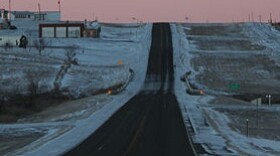A national transportation group says South Dakota’s roads and bridges are deteriorating and a major contributing factor is lack of funding. Researchers for the group called TRIP say numbers from local reports and studies show the state’s roads and bridges continue to break down. The report shows the condition of pavement is getting worse, and it could take the economy with it.
Thirty-nine percent of South Dakota’s county roads are failing. Twenty-eight percent of township roads are in poor condition or closed. Although right now just two percent of the state roadways are in poor condition, that number could be a quarter of all state highways a decade from now. That’s according to South Dakota data compiled by a national transportation research group called TRIP.
Rocky Moretti says funding is a major hurdle to sustaining roads and bridges.
"The South Dakota Department of Transportation is putting $6 million into local bridges, and they estimate at that rate it’ll take them 40 years to fix all of the currently structurally deficient bridges that are out there. And, of course, as that happens, lots of other bridges are deteriorating," Moretti says.
Moretti says other states have weighed the costs of maintaining their roads with the benefits, and a new report from Oregon shows infrastructure maintenance matters to a state’s economy.

"To prevent that $9.4 billion dollar drop in GDP, it would take an $800 million investment in road and bridge repairs," Moretti says. "The bottom line is they concluded that the cost/benefit of making was 12 to one."
Moretti says roads and bridges don’t deteriorate overnight, so no easy fix can bring them back to acceptable condition.
"I think the challenge in transportation is that, unlike say something like utilities where clearly the fees you pay are essentially tied into the cost of keeping the system in a state of good repair, in transportation, every so often the amount that’s going to be spent is set and then over time the erosion occurs," Moretti says.
This year’s report from TRIP is one of several major reality checks about South Dakota’s roads and bridges, according to the president and CEO of the Sioux Falls Chamber of Commerce. Evan Nolte says leaders need a plan to restore the system.

"I don’t know that any of us necessarily look at wanting to see increases, but I believe that the return on investment, I think that there’s a consensus building in reality that we need to do something, and we need to make sure that we reinvest," Nolte says.
Lawmakers in Pierre are considering fee and tax hikes to support the state’s transportation infrastructure. Nolte says the numbers considered between $50 million and $100 million don’t meet the state’s needs.
Senate Bill 1 contains tax and fee increases to benefit road and bridge repair. That’s the primary piece of legislation lawmakers are using to address the infrastructure concerns.
You can view the entire South Dakota transportation report from TRIP at this link.






